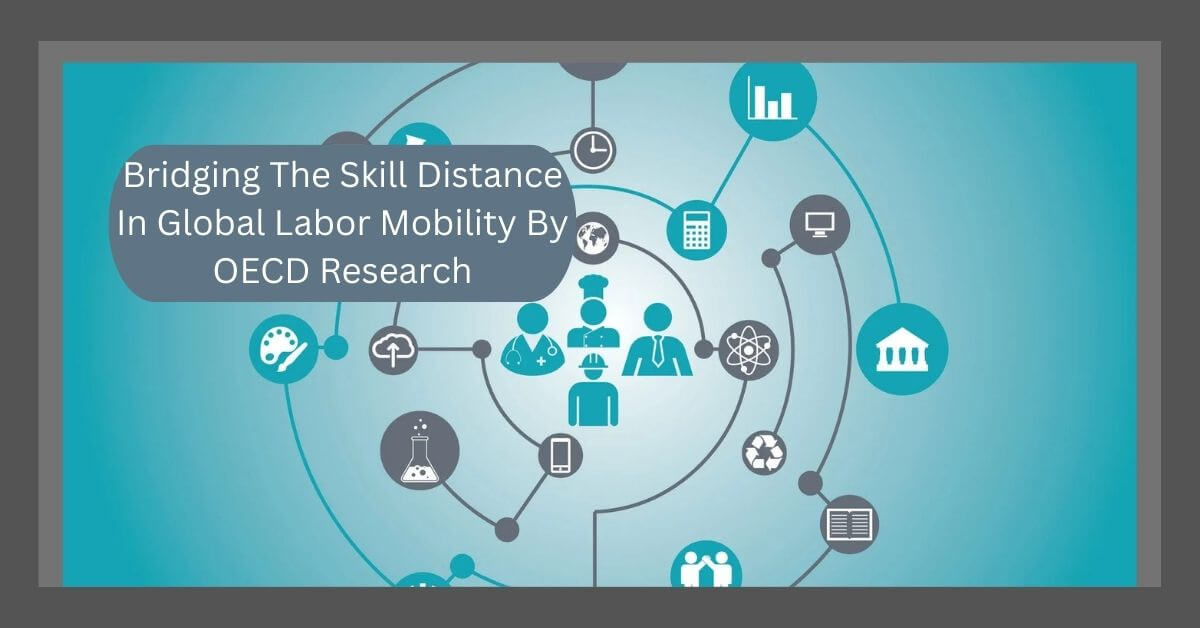Explore how the OECD’s 2025 research on global labor mobility, “Bridging the Skill Distance,” highlights the importance of reducing skill mismatches to support cross-border job transitions. The study reveals that moving between mid‑level roles (e.g., technician to technician) often requires minimal retraining, while shifts from low‑skilled to high‑skilled positions may need up to a year of retraining.
Additionally, the OECD finds that a learner’s attitude—specifically, a readiness to learn—plays a pivotal role in overcoming skill gaps and successfully adjusting to new roles abroad . This research underscores that bridging the “skill distance” is not only about qualifications but also about adaptability and workplace readiness, shaping more effective global labor mobility strategies.
What Are Occupation Skill Distances?
In layman’s terms, skill distance gauges the amount of training or education required to transition from one occupation to another. The OECD study employed two (2) talent types to analyze 127 occupations in 31 countries:
- Cognitive Skills – Literacy and numeracy (e.g., data interpretation, analytical reasoning).
- Task-Based Skills—including self-organization, administration, selling, and the use of information and communication technologies (ICTs).
Key Findings for Foreign Skilled Workers in New OCED Report:
As per my analysis, there are 4 major findings in OCED moving between jobs report for foreign skilled workers:
1# Some Career Moves Require Less Effort Than Others:
- The skill disparity is frequently minimal when transitioning from a mid-skilled position to another mid-skilled position (e.g., clerk to technician), necessitating less retraining.
- Nevertheless, the cognitive skill disparity is significantly greater when transitioning from low-skilled to high-skilled positions (e.g., factory worker to engineer), frequently necessitating up to one full year of retraining or more.
2# ICT, Communication & Self-Management Are Key:
Want to move into managerial, technical, or professional roles abroad? – You’ll likely need strong task-based skills, such as:
- Information and communication technology (ICT) literacy (online systems, email, Excel)
- Persuasion and communication
- Self-organization and planning
The study shows that these are often the main bottlenecks preventing upward mobility—even if your cognitive skills are already strong.
3# High-Skilled Workers Still Need On-the-Job Training:
Even if you’re already a professional (e.g., software engineer), moving up to managerial positions still requires you to build task-specific skills, like managing teams or budgeting. So while cognitive skill gaps may be small, foreign workers should prepare for:
- Mentorship in the workplace
- Specialized certifications (e.g., Six Sigma, PMP)
- development of soft skills
4# “Readiness to Learn” is a Game-Change:
One disregarded asset is your disposition toward learning. The OECD study discovered that workers who demonstrated a willingness to acquire new skills had a simpler time transitioning between employment, even when the skill gap was substantial. It is an indispensable delicate skill that foreign employers prioritize when choosing candidates.
What This Means for Migrating Skilled Workers?
If you’re aiming to migrate under a work visa program like the:
You must strategically choose a target job where:
- The destination position is closely aligned with your current skill set.
- The period of retraining is brief.
- The skills are not readily automated, such as care work, problem-solving, or people management.
Check Also: H-1B Visa Cap and Lottery Process for Employers
Real Example: Moving from Clerical to Technical Roles:
The OECD report provides a skill comparison for this scenario: Clerical Support Worker → Numerical Clerk
- Cognitive Skill Gap: Moderate (about 0.8 years of retraining)
- Task-Based Skill Gap: Manageable (with basic ICT and numeracy training)
A practical, achievable switch! – Now contrast that with:
Clerical Worker → Professional Engineer
- Cognitive skill gap: Significant (most likely two or more years of education)
- Task-Based Skills: Necessitates advanced ICT and numeracy abilities
What You Should Do Next?
- Match your present occupation with ISCO-08 codes, which are employed in global labor statistics.
- Estimate the distance between your current location and the positions that are in high demand in your destination country by utilizing the OECD’s findings.
- Invest in targeted skills training, with a particular emphasis on workplace autonomy, digital communication, and ICT tools.
- Demonstrate your willingness to acquire new knowledge in your curriculum vitae and interviews.
- Avoid occupations that are at a high risk of automation, regardless of whether they are “easy to get into.”
Reference:
This blog post is based on:
“Moving Between Jobs: An Analysis of Occupation Distances and Skill Needs” – OECD Science, Technology and Industry Policy Papers No. 52, June 2018.
Available at: https://www.oecd.org/en/publications/moving-between-jobs_d35017ee-en.html.
Frequently Asked Questions:
What is the “skill distance” in global labor mobility?
Skill distance refers to the gap between:
The skills international workers possess, and
The skills required by employers in the host country.
This mismatch often leads to underemployment or occupational downgrading, where skilled migrants work in jobs below their qualification level.What was the focus of the OECD’s July 2025 research?
The OECD’s 2025 study examined:
How skill mismatches affect international labor mobility
Patterns of overqualification among migrant workers
The impact of regulatory barriers, non-recognition of credentials, and language skills
Policy options to reduce underutilization of migrant talentWhat were the key findings?
Highlights include:
40–60% of foreign-born workers in high-income countries are employed in jobs below their education level
Women and non-native language speakers face greater skill underutilization
Migrants from low- and middle-income countries are more likely to be overqualified for their roles
A lack of transparent skill recognition frameworks contributes significantly to the mismatch






